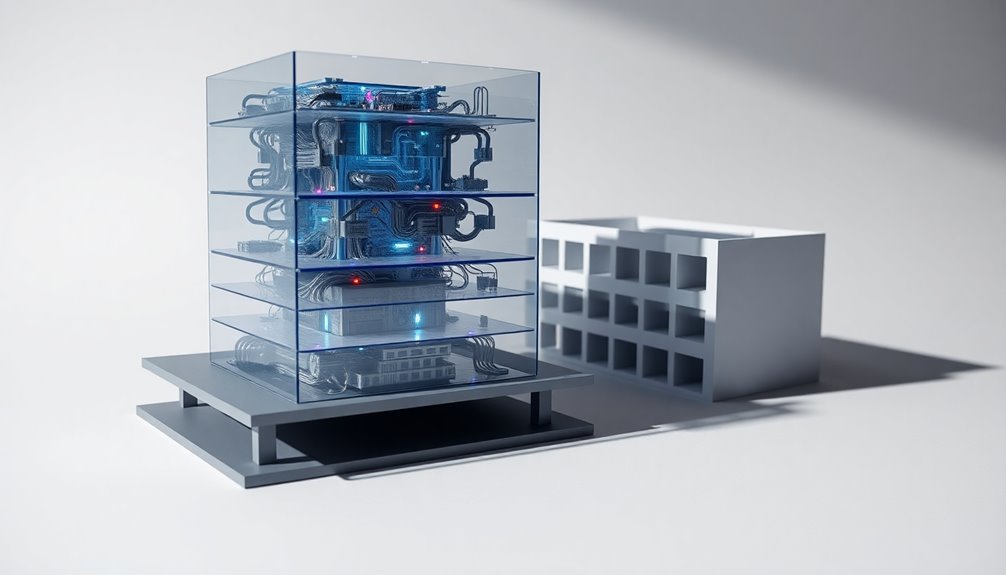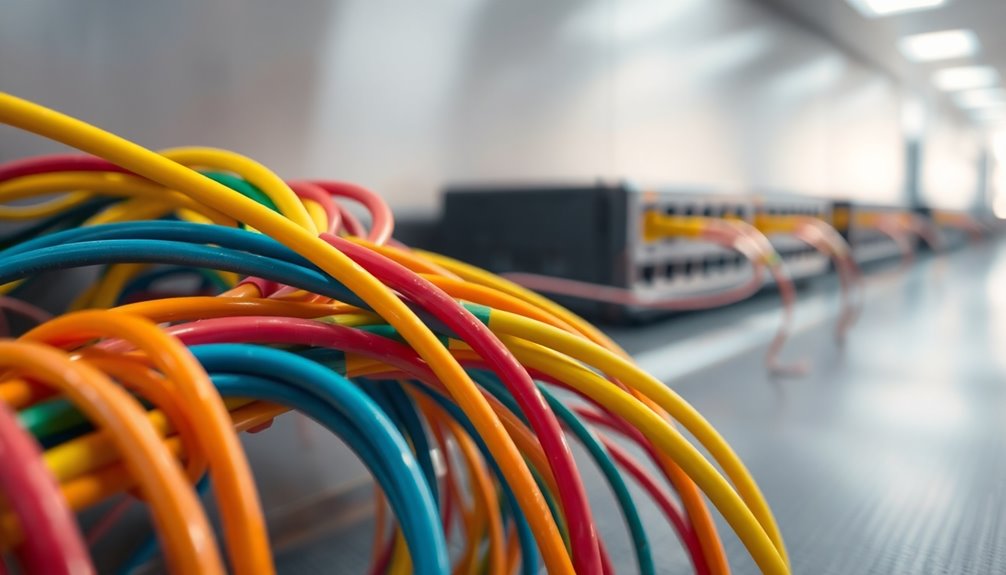The layers of networking are essential for efficient data communication. You'll encounter the network layer, which handles addressing, routing, and packet fragmentation. It uses protocols like IPv4 to manage data transmission effectively. You'll also notice the transport layer, dealing with data flow control and error checking. Other important layers include the data link layer, which ensures packet integrity, and the physical layer, which handles electric signals. Together, these layers improve performance, security, and reliability. As you explore further, you'll uncover the intricacies of each layer and how they impact your network operations.
Key Takeaways
- The networking layer is responsible for routing data packets, addressing, and ensuring efficient communication between devices in a network.
- It is distinct from the transport layer, which focuses on end-to-end communication and reliability of data transmission.
- Key networking protocols include IPv4 for addressing and OSPF for efficient packet routing across networks.
- Network layers include application, transport, network, data link, and physical layers, each serving specific functions in the communication process.
- Understanding network topologies, such as bus, ring, and star, is crucial for designing effective networking systems.
Networking Layer Overview

The networking layer serves as the backbone of data communication in modern networks. It handles critical tasks like addressing, assigning unique IP addresses to devices, and ensuring data packets reach their intended destinations through efficient routing. The networking layer is an integral part of the OSI model, which is critical for the functionality of the internet.
You'll find that it fragments data packets too large for the maximum transmission unit (MTU) and reassembles them at their destination, maintaining smooth communication. Quality of Service (QoS) prioritizes important traffic, ensuring that vital data gets the bandwidth it needs.
Additionally, it manages error handling during data transmission, correcting issues that may arise. By utilizing protocols like IPv4 and OSPF, the networking layer ensures global connectivity and efficient data transmission across interconnected networks, making it essential for seamless communication.
Networking Fundamentals Explained Here

While understanding networking fundamentals might seem daunting at first, grasping the core concepts can significantly enhance your ability to navigate modern communication systems.
The network layer focuses on switching, routing, and creating logical paths for data. It manages routing, addressing, and error handling, ensuring efficient data transmission. This layer is crucial in facilitating data transmission between networks.
On the other hand, the transport layer guarantees a seamless transfer of data between systems, providing error recovery and flow control. It determines segment sizes and transmission rates to optimize performance.
Additionally, understanding network topologies—like bus, ring, star, and mesh—helps you visualize how devices connect and communicate.
Data Packet Transmission Process

Understanding the data packet transmission process is essential for grasping how information travels across networks.
First, your data gets broken into smaller units called packets, each containing part of the data along with source and destination addresses. This packet formation happens at your device, like a computer or server.
Once formed, packets are sent via a network interface card (NIC), converting the data into electrical signals. As they travel, routers and switches determine the best path, adapting to network conditions. This routing process is influenced by dynamic network conditions, which may alter packet paths based on current traffic.
When they reach the destination, the receiving device reassembles them using sequence numbers to ensure the correct order. If any packets are missing, it can request retransmission, maintaining the integrity of your data.
Pros and Cons

When you consider the distribution layer in networking, weighing its pros and cons becomes crucial for effective network design.
On the plus side, the distribution layer aggregates access devices, ensures policy-based connectivity, and enhances redundancy and high availability. It also segments networks, isolating issues to prevent core layer disruptions, allowing for improved network security through the implementation of access control lists and traffic monitoring.
However, this layer adds complexity and potential performance overhead, complicating management and updates. Layer 3 switches enhance capabilities, but they can introduce slower speeds and increased latency due to packet inspection.
Plus, their advanced functionalities come at a higher cost and require more resources. Balancing these pros and cons helps you create a robust and efficient network architecture tailored to your needs.
Layered Architecture vs. Flat Design

How does the choice between layered architecture and flat design impact your network's performance and scalability?
Layered architecture offers modularity, breaking tasks into manageable layers where changes in one won't affect the others. This independence enhances troubleshooting and overall efficiency. Additionally, layered networks can utilize network segmentation to improve security, making them more resilient against threats. Furthermore, AI automation can enhance decision-making within layered architectures by providing data-driven insights for network management.
You'll also enjoy better scalability, allowing your network to grow without significant redesign.
On the flip side, flat design simplifies setup and reduces costs, but it lacks control and can lead to performance issues due to broadcast traffic.
With no segmentation, troubleshooting becomes challenging, and a single point of failure can cripple your network.
Ultimately, choosing layered architecture provides more flexibility and reliability, while flat design may limit your network's future growth and effectiveness.
Security Vulnerabilities in Networking

While networking offers numerous advantages, it also exposes systems to various security vulnerabilities that can compromise data integrity and availability.
At the physical layer, unauthorized access can lead to serious threats, so monitoring and biometric security are essential.
Data link vulnerabilities like VLAN hopping require strong encryption and MAC address filtering.
The network layer faces DDoS attacks, necessitating robust firewalls and secure protocols.
At the transport layer, be cautious of SYN floods; secure your protocols and error-checking functions.
Session hijacking can jeopardize your data, so use encryption like HTTPS. Additionally, known vulnerabilities in outdated software can create critical entry points for cyber attackers.
Moreover, watch for phishing and insider threats; they often exploit weak points. Regular updates and strict access controls can significantly mitigate these risks, keeping your network safe.
G Network Advancements

As technology rapidly evolves, G Network advancements are reshaping the way we connect and communicate.
You'll notice how multi-G network architecture, featuring software-based Open RAN, enables seamless coexistence of 4G, 5G, and 6G. This innovation improves spectral efficiency, ensuring minimal stranded spectrum. The continuous increase in demand for mobile bandwidth highlights the necessity for these advancements to meet user expectations.
With edge data centers enhancing policy enforcement, you'll experience better connectivity. The integration of 6G capabilities, such as high-speed internet up to 11 Gbps and satellite support, promises faster, more reliable communication.
Additionally, partnerships like Boldyn Networks and G.Network bolster smart city initiatives through full-fibre broadband. These advancements create a more connected infrastructure, aligning with the vision for safer, prosperous urban living.
Embracing these technologies means embracing a future of enhanced communication.
Optimize Network Traffic Flow

To ensure a smooth online experience, optimizing network traffic flow is essential for any organization. Start by assessing and monitoring your network traffic to identify bottlenecks and prioritize critical applications. Use real-time monitoring to catch issues as they arise and analyze traffic patterns to allocate resources effectively. Implement Quality of Service (QoS) policies to prioritize latency-sensitive traffic, ensuring applications like VoIP receive the bandwidth they need.
Leverage load balancing techniques to distribute traffic evenly, preventing any single server from becoming overwhelmed. Additionally, optimize your network configuration and hardware by updating router firmware and investing in high-performance equipment. Regular maintenance will keep your network running at its best, ensuring consistent performance across all applications.
Frequently Asked Questions
What Are the Main Protocols Used in Each Networking Layer?
When you explore networking, you'll encounter several key protocols for each layer.
At the Application Layer, protocols like HTTP and FTP are vital.
For the Presentation Layer, data formatting standards come into play.
The Session Layer manages sessions using protocols like NetBIOS.
In the Transport Layer, TCP and UDP ensure reliable data delivery.
The Network Layer uses IP for routing, while the Data-Link Layer employs Ethernet, and the Physical Layer focuses on transmission standards.
How Do Different Layers Interact Within the Networking Model?
Imagine a well-orchestrated symphony; each musician plays their part in harmony.
In networking, different layers interact seamlessly to ensure data flows smoothly. As data descends through layers, each one adds its own header, preparing it for transport.
When it reaches the destination, layers work in reverse, stripping away those headers and ensuring the message's integrity.
This collaboration allows reliable communication, with each layer performing its specific role effectively without missing a beat.
What Tools Are Available for Network Analysis and Monitoring?
When you need to analyze and monitor your network, several tools can help.
You can use Nagios XI for customizable notifications and visual displays of issues. LogicMonitor automates device discovery across various environments.
PRTG Network Monitor offers sensors for tracking bandwidth and hardware performance, while Datadog provides in-depth analysis for network performance.
Each tool has unique features, so you can choose one that best fits your specific monitoring needs.
How Do Network Layers Affect Overall Network Performance?
Network layers significantly impact overall performance by influencing data transmission efficiency.
You'll notice that each layer, from the physical to the transport, plays a role in latency, throughput, and error management. For instance, if the network layer optimizes routing, you experience faster data delivery.
Meanwhile, the transport layer ensures reliable transmission, adjusting to network conditions. Understanding how these layers interact helps you troubleshoot issues and enhance your network's performance effectively.
What Role Does Hardware Play in Networking Layers?
Hardware plays a crucial role in networking layers by enabling communication and data transfer.
You'll find devices like switches and routers facilitating data flow, while modems and cables ensure signals travel effectively.
Network adapters connect your devices to the network, allowing for seamless transmission.
Conclusion
In a world where connections matter, understanding the layers of networking is your secret weapon. You've explored the fundamentals, data transmission, and the balance of pros and cons. Remember, a layered architecture often outshines a flat design, much like a well-structured novel captivates its readers. As you navigate security challenges and G network advancements, you'll be better equipped to optimize traffic flow. Embrace these insights, and watch your networking skills soar like an eagle in the sky!









